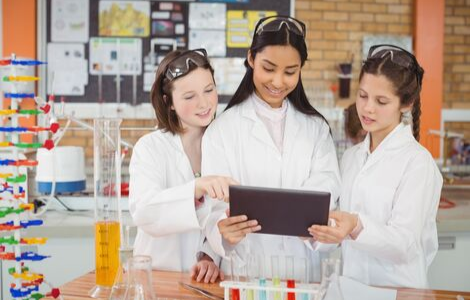I think it is fair to say that the “digital classroom conversion” begins as soon as 100% of your students have access to 1:1 devices, the Internet, and each other. My digital conversion began five years ago with a class set of iPads. Like so many other teachers, I worked really hard to ensure successful deployment of hardware and to always use the coolest apps available.
The kids came to my class each day, excited to see what was going to happen next. I was determined to go “paperless” cold-turkey. Everything my class did was done digitally. As the first couple of months passed and many eager visitors came and went, my students enthusiasm lost some momentum. It was like a slap in the face when I heard one of my students say to a visiting administrator, “the iPads… they’re ok, it was fun in the beginning, but I don’t think I’m any smarter.”
Hearing my student speak so frankly made me question myself, the extraordinary time spent planning, and ultimately the capital investment my school district made. Could we have been wrong? Did going 1:1 not change anything?
After some reflecting, it became obvious to me that I was still teaching as if the students didn’t have any access to technology at all. Most of the tasks students were completing were nothing more that sophisticated poster board presentations. The simple fact that we were using technology, didn’t mean I was integrating the power it could give to students and teachers. It was time to change.
SAMR: a nice starting point
The development of the SAMR model, by Dr. Ruben Puentedura, and its widespread use certainly helped educators like me audit the tasks I was assigning. Much of my initial work was in the enhancement phase (substitution - augmentation). Rarely did my early work reach the transformational level (modification - redefinition). Of course, the great transformation is what everyone in my school was hoping for. The problem we faced was that no one really understood how to elevate the use of technology so that deeper learning would take place.
Substitution
Augmentation
Modification
Redefinition
Enhancement to Transformation
As my exploration, professional development, and curiosity grew, I began to understand the common elements of successful lessons in my classroom. My best lessons were the ones when both the students and I knew about any gaps in my teaching and their learning. Even more noticeable changes in student behavior and approach to assignments was when students had an audience greater than one person; me. As I progressed in utilizing more and more digital formative assessments, it completely changed my approach to lesson planning as a teacher.
My classroom began to transform into a student-centered workshop as I tweaked my pedagogy. The best learning always takes place when a student produces something. When ever I gave my class a choice to complete tasks different ways, they had greater ownership of their learning. I also began to realize that students were certainly capable of making their own notes rather than always completing worksheets and such. The iPads definitely allowed students to create enhanced notes that included colorful sketches, beautiful images from the web, live links to deeper content, and so on. The biggest change took place when students donated their work to digital spaces. No longer was their work just for me, it was for the entire class. We all quickly understood that students had to bring their “A” game when their learning was on display.
Donations to Digital Spaces
I had obvious concerns for my struggling learners who might take longer or were not ready to showcase their work. One of the greatest advantages that heterogeneous groupings gives classrooms is all the different levels of work that it can produce. In digital spaces, students are now able to reflect on other students’ work in their own class. Too often, students only worked with a classmate who sits directly next to them. I began to see my lower achieving students learn from students they may have never even spoken with earlier in the school year. Every day my classroom was virtually a gallery-walk of student work. As soon as a student donated their work to our digital space, they were able to reflect how their work compared with others. Thus, students began asking for more opportunities to re-do their work. Seriously?? For the first time in my career, students were regularly requesting to do revisions. I was glad to score their second or third attempts. The kids were excited to see their grades increase and their knowledge grow. PONDRR was born.
PONDRR
As my partner Scott and I collaborated on the digital conversion, we were convinced that if we began lesson planning using PONDRR as our focus, we could elevate all of our lessons from Puentedura’s substitution-augmentation levels (enhancement phase) to augmentation-redefinition level; thereby transforming the classroom.
Produce
Ownership
Notemaking
Donate
Reflect
Revise
By designing instruction that trains students to naturally progress through the phases of PONDRR, students participate as workers in the classroom that places them at the center of their own individualized authentic learning experience.
Please feel free to download the files to help transform your instruction.



